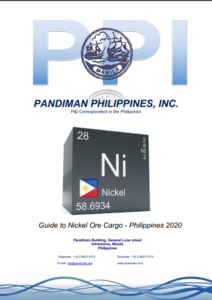The UK P&I Club shared a guide from its correspondent Club, Pandiman Philippines, concerning the potential dangers related to Nickel ore cargo, locations of loading areas, the importance of sampling and certification.
Nickel ore is considered as ‘the world’s most dangerous cargo‘.
Concerning the Philippines, there is a number of concerns, mines stock pile nickel ore in open conditions on or near the foreshore, there are no actual piers or port facilities at the locations and the ore is loaded offshore at anchor via barges.
Moreover, the ore is unprocessed and is obtained from open cast mining and therefore exposed to the elements, especially rain during monsoon seasons, however in recent years the clear demarcation between dry and wet seasons has diminished and rain can be experienced any time of the year.
A major concern for ship owners and their P&I Clubs is the property of the nickel ore, which when carried in bulk, can liquefy through the motion of the ship in a seaway or vibration of the ship through main engine/on board machinery. This ability of the cargo to transform from an apparent solid state to a liquid one when the cargo has a high moisture content can have serious and catastrophic effects to the vessels stability and has resulted in vessels capsizing and sinking within minutes.
This property of the cargo should not be mistaken with free surface effect (sloshing), the cargo during liquefaction undergoes a metamorphosis between a solid to a liquid, changing between these states unexpectedly and is a dynamic shift. Once the cargo has shifted it will not come back, this shift resulting in the loss of the vessels stability with resulting list or capsizing.
The Club highlights the importance being fully compliant to the IMSBC Code, and advises:
- Notified in advance of the intended vessels arrival.
- Inspection of the mine site and visual confirmation of the stockpiles assigned to be loaded.
- Samples taken in co-ordination with the mine and bureau of mines.
- samples sent to independent laboratory (currently abroad).
- That the vessel does not commence loading until results have been obtained from the independent laboratory.
In addition, loading will be monitored throughout that the cargo is from the allocated stock piles, weather conditions are observed, especially periods of heavy rain and that suitable measures are being taken to protect the stockpiles or cargo on board barges.





























































